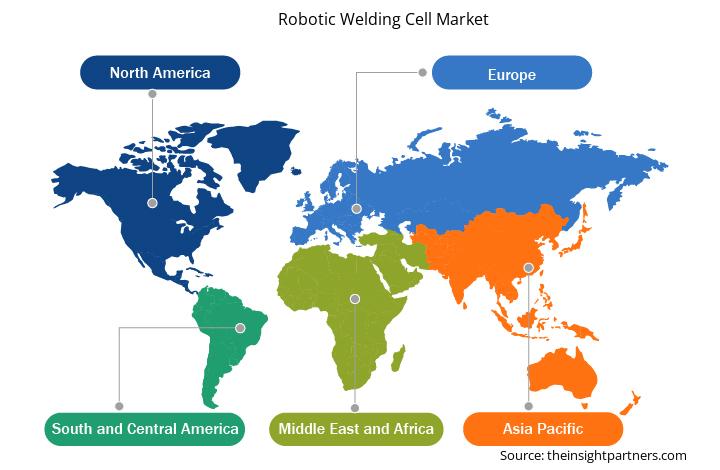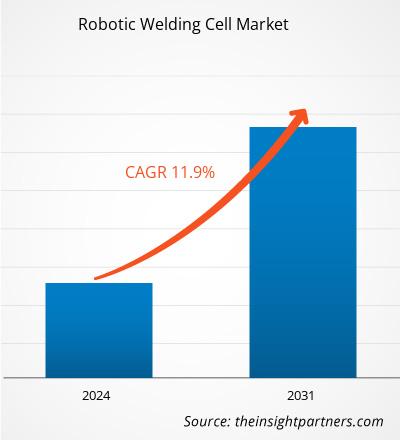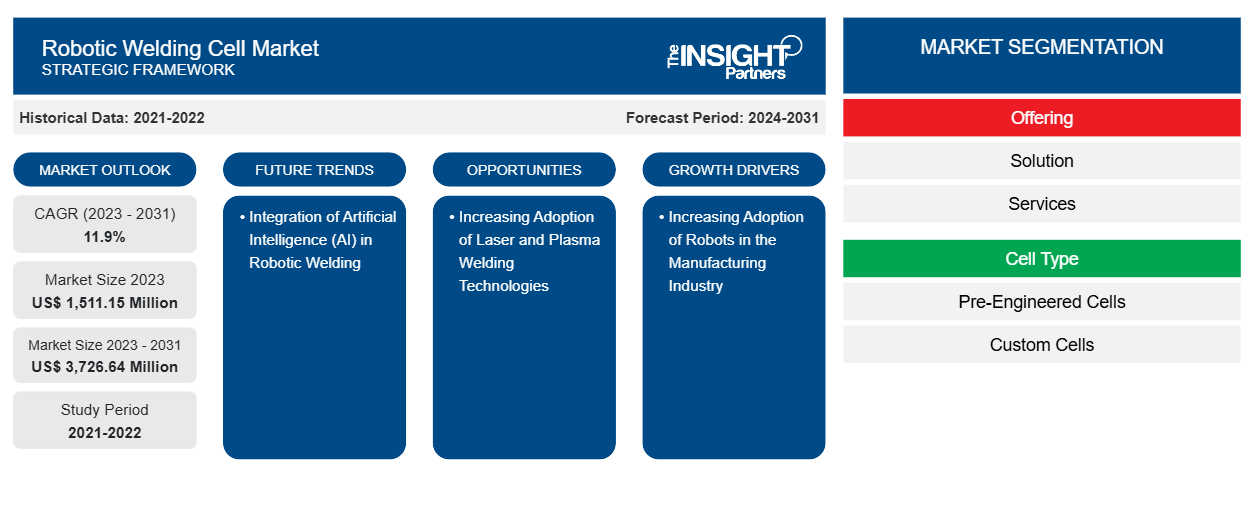من المتوقع أن يصل حجم سوق خلايا اللحام الروبوتية إلى 3,726.64 مليون دولار أمريكي بحلول عام 2031 من 1,511.15 مليون دولار أمريكي في عام 2023. ومن المتوقع أن يسجل السوق معدل نمو سنوي مركب بنسبة 11.9٪ خلال الفترة 2023-2031. ومن المرجح أن يؤدي التبني المتزايد لتقنيات الصناعة 4.0 إلى ظهور اتجاهات رئيسية جديدة في السوق في السنوات القادمة.
تحليل سوق خلايا اللحام الروبوتية
تتكون خلية اللحام الروبوتية من عدة مكونات تعمل معًا على لحام الأجزاء. توفر خلايا اللحام الروبوتية عمليات لحام من الطراز العالمي وهي مصممة وفقًا للمعايير العالمية لتوفير تكاليف المشغل والوقت. الخلايا المصممة مسبقًا هي خلايا لحام روبوتية فعّالة من حيث التكلفة وتتضمن فقط المكونات الأساسية الضرورية لعمليات اللحام. يمكن تثبيت هذا الهيكل الأساسي للخلايا بسرعة؛ مما يسمح للمصنعين بتقليل وقت إنتاج الخلية وتسليم المنتج النهائي في أقرب وقت ممكن. الخلايا المخصصة باهظة الثمن مقارنة بالخلايا المصممة مسبقًا لأنها تتضمن معدات فريدة إلى جانب المكونات الأساسية الأساسية. يتم تصنيعها بشكل أساسي وفقًا لمصالح العميل المحددة. وبالتالي، فإن الوقت المطلوب لتصنيع وتسليم خلية لحام روبوتية مخصصة أعلى من الوقت المطلوب لتصنيع وتسليم خلية مصممة مسبقًا. تُستخدم روبوتات اللحام على نطاق واسع في صناعة السيارات. الطلب على المركبات يتزايد بشكل ملحوظ. يعد الإنفاق الاستهلاكي المتزايد أحد العوامل التي تدفع الطلب على المركبات في جميع أنحاء العالم، وخاصة في الدول الآسيوية. وفقًا للبيانات التي نشرتها المنظمة الدولية لمصنعي السيارات في عام 2024، وصل إجمالي إنتاج المركبات إلى 93 مليونًا في عام 2023، بزيادة قدرها 12٪ من عام 2021 إلى عام 2023. وقد أدى الارتفاع في بناء المرافق الجديدة إلى زيادة الطلب على روبوتات اللحام في هذه المرافق الجديدة للسيارات، مما أدى في النهاية إلى دفع سوق خلايا اللحام الروبوتية.
نظرة عامة على سوق خلايا اللحام الروبوتية
تشمل الجهات المعنية الرئيسية في النظام البيئي العالمي لسوق خلايا اللحام الروبوتية موردي المواد الخام / المكونات ومصنعي خلايا اللحام الروبوتية والمنظمات الحكومية والهيئات التنظيمية والعملاء النهائيين. يوفر موردو المكونات والأجهزة مكونات وأجزاء مختلفة لمصنعي خلايا اللحام الروبوتية. الشركات المصنعة الرئيسية لخلايا اللحام الروبوتية المدرجة في هذا التقرير هي Abb Ltd و Acieta LLC و Carl Cloos Schweisstechnik Gmbh و Kawasaki Heavy Industries، Ltd؛ Kuka AG؛ Phoenix Industrial Solutions؛ The Lincoln Electric Company؛ Wec Group Ltd.؛ و Yaskawa America، Inc.؛ من بين آخرين. بعد مصنعي خلايا اللحام الروبوتية، هناك العديد من الجهات المعنية الطرفية في سوق خلايا اللحام الروبوتية العالمية، والتي تلعب دورًا حاسمًا في تمكين التقدم التكنولوجي وتبني خلايا اللحام الروبوتية.
قم بتخصيص هذا التقرير ليناسب متطلباتك
ستحصل على تخصيص لأي تقرير - مجانًا - بما في ذلك أجزاء من هذا التقرير، أو تحليل على مستوى الدولة، وحزمة بيانات Excel، بالإضافة إلى الاستفادة من العروض والخصومات الرائعة للشركات الناشئة والجامعات
- احصل على أهم اتجاهات السوق الرئيسية لهذا التقرير.ستتضمن هذه العينة المجانية تحليلاً للبيانات، بدءًا من اتجاهات السوق وحتى التقديرات والتوقعات.
محركات وفرص سوق خلايا اللحام الروبوتية
تزايد استخدام الروبوتات في صناعة التصنيع
تلعب الروبوتات دورًا مهمًا في صناعة التصنيع. تساعد الروبوتات في زيادة الكفاءة والإنتاجية بشكل عام في عمليات الإنتاج. يتم استخدامها في صناعة التصنيع لتطبيقات مختلفة مثل التجميع والتوزيع، والمناولة والاختيار، والتشغيل والقطع، واللحام، والصب والتشكيل، والتشطيب والصنفرة، والطلاء والطلاء، والتنظيف والنظافة، والخدمات اللوجستية والتخزين، والتعبئة والتغليف. وفقًا للبيانات التي نشرها الاتحاد الدولي للروبوتات في عام 2024، كان هناك ما يقرب من 4.2 مليون روبوت يعمل في المصانع في جميع أنحاء العالم في عام 2023، بزيادة عن 3.9 مليون في عام 2022. وكما ذكر الاتحاد الدولي للروبوتات في عام 2021، سيتم استخدام نصف إجمالي الروبوتات العاملة في المصانع لتطبيقات اللحام. وبالتالي، فإن التبني المتزايد للروبوتات في صناعة التصنيع يدفع نمو سوق خلايا اللحام الروبوتية.
تزايد استخدام تقنيات اللحام بالليزر والبلازما
يتزايد الطلب على اللحام بالليزر بسرعة. تستخدم تقنية اللحام بالليزر أشعة الليزر عالية الطاقة التي تم تطويرها باستخدام ثاني أكسيد الكربون والنيتروجين والهيليوم. يساعد هذا في ربط المواد بدقة وسرعة عالية. تزداد شعبية اللحام بالليزر بسبب التشوهات الضئيلة والقدرة على لحام مواد مختلفة. بالإضافة إلى ذلك، من خلال تحسين كفاءة الليزر وتحسين عملية اللحام، يمكن تحقيق الحفاظ على الطاقة بشكل عام باستخدام هذا النوع من تقنية اللحام. هذا هو أحد العوامل المهمة التي تزيد من الطلب على اللحام بالليزر، حيث يعد تقليل استهلاك الطاقة أحد الاهتمامات الرئيسية في جميع أنحاء العالم.
علاوة على ذلك، عند دمجها مع التقنيات المتقدمة مثل الذكاء الاصطناعي والتعلم الآلي، يمكن لتقنية اللحام هذه أن تعمل بكفاءة. وبالتالي، فإن الطلب على تقنية اللحام بالليزر يتزايد بشكل ملحوظ. وبالمثل، توفر تقنية اللحام بالبلازما مزايا مختلفة، بما في ذلك كثافة الطاقة العالية، واللحامات النظيفة والناعمة، وسرعة اللحام العالية، والتشوهات المنخفضة، وتحسين سد الفجوات. اللحامات الناتجة عن اللحام بالبلازما قوية جدًا وأقل وضوحًا.
تقرير تحليل تجزئة سوق خلايا اللحام الروبوتية
إن القطاعات الرئيسية التي ساهمت في اشتقاق تحليل سوق خلايا اللحام الروبوتية هي قطاع العرض ونوع الخلية وصناعة الاستخدام النهائي.
- بناءً على العرض، ينقسم سوق خلايا اللحام الآلية العالمية إلى حلول وخدمات. استحوذ قطاع الحلول على حصة سوقية أكبر في عام 2023 ومن المتوقع أن يسجل معدل نمو سنوي مركب أعلى خلال فترة التوقعات. تساعد حلول خلايا اللحام الآلية الشركات المصنعة على تحقيق قدرتها الإنتاجية الإضافية وتخفيف مشاكل نقص العمالة. تعمل مثل هذه المزايا التي تتمتع بها خلايا اللحام الآلية مقارنة بعمليات اللحام اليدوي على دفع الطلب على خلايا اللحام الآلية.
- بناءً على نوع الخلية، يتم تقسيم سوق خلايا اللحام الآلية العالمية إلى خلايا مُصممة مسبقًا وخلايا مخصصة. هيمنت شريحة الخلايا المُصممة مسبقًا على شريحة أنواع الخلايا بحصة سوقية تبلغ 68.3٪ في عام 2023، ومن المتوقع أن تسجل شريحة الخلايا المخصصة معدل نمو سنوي مركب أعلى خلال فترة التنبؤ. خلايا اللحام الآلية المُصممة مسبقًا هي خلايا لحام آلية قياسية لها مساحة عمل أكبر مع روبوت معالج أطول وطاولتين أكبر. من ناحية أخرى، يتم تصنيع الخلايا المخصصة وفقًا لمتطلبات المستخدم النهائي ويتم تخصيصها لصناعات محددة.
- بناءً على صناعة الاستخدام النهائي، يتم تقسيم سوق خلايا اللحام الآلية العالمية إلى صناعة السيارات والتصنيع والفضاء والدفاع. استحوذ قطاع السيارات على ثاني أكبر حصة من السوق ومن المتوقع أن يسجل أعلى معدل نمو خلال فترة التنبؤ. أحد العوامل التي تدفع الطلب من صناعة السيارات هو زيادة إنتاج ومبيعات المركبات في جميع أنحاء العالم. من المتوقع أن تسجل صناعة التصنيع معدل نمو سنوي مركب ملحوظ خلال فترة التنبؤ. أحد العوامل التي تدفع الطلب على خلايا اللحام الآلية في قطاع التصنيع هو اتجاه التصنيع المتزايد في جميع أنحاء العالم، وخاصة في البلدان النامية.
تحليل حصة سوق خلايا اللحام الروبوتية
يقدم النطاق الجغرافي لتقرير سوق خلايا اللحام الروبوتية تحليلاً إقليميًا وقطريًا مفصلاً. أمريكا الشمالية وأوروبا ومنطقة آسيا والمحيط الهادئ هي مناطق رئيسية تشهد نموًا كبيرًا في سوق خلايا اللحام الروبوتية. شكلت الصين ما يقرب من 60٪ من حصة السوق في العدد الإجمالي لتركيبات الروبوتات في عام 2022. قامت الصين بتثبيت حوالي 0.2 مليون روبوت في عام 2022، بينما قامت اليابان بتثبيت أكثر من 50000 وحدة في عام 2022، وهي ثاني أكبر سوق عالميًا. بصرف النظر عن الصين واليابان، تعد سنغافورة والهند وتايلاند من بين الأسواق الرئيسية في منطقة آسيا والمحيط الهادئ.
استحوذت أوروبا على ثاني أكبر حصة سوقية في تركيبات الروبوتات الصناعية وصناعة خلايا اللحام الروبوتية. وكانت ألمانيا أكبر سوق في أوروبا لخلايا اللحام الروبوتية والروبوتات الصناعية في عام 2023. ومن العوامل التي تدفع الطلب على خلايا اللحام الروبوتية التركيز على زيادة تبني تقنيات الصناعة 4.0 في ألمانيا. وتعد ألمانيا وفرنسا والمملكة المتحدة وإيطاليا من بين الدول التي تحظى بحصص بارزة في سوق خلايا اللحام الروبوتية.
تعد أمريكا الشمالية واحدة من الأسواق البارزة لخلايا اللحام الروبوتية نظرًا لوجود عدد قليل من شركات التصنيع المهمة عبر الصناعات المختلفة، وزيادة الحاجة إلى الصناعة 4.0، وارتفاع الطلب على التكنولوجيا المتقدمة. استحوذت الولايات المتحدة على أكبر حصة من السوق بسبب اتجاهات التصنيع والرقمنة في البلاد. بالإضافة إلى ذلك، تعد الولايات المتحدة موطنًا لعدد قليل من شركات تصنيع السيارات والطيران الكبرى، مثل تسلا وبوينج وفورد موتورز.
رؤى إقليمية حول سوق خلايا اللحام الروبوتية
لقد قام المحللون في Insight Partners بشرح الاتجاهات والعوامل الإقليمية المؤثرة على سوق خلايا اللحام الروبوتية طوال فترة التوقعات بشكل شامل. يناقش هذا القسم أيضًا قطاعات سوق خلايا اللحام الروبوتية والجغرافيا في جميع أنحاء أمريكا الشمالية وأوروبا ومنطقة آسيا والمحيط الهادئ والشرق الأوسط وأفريقيا وأمريكا الجنوبية والوسطى.

- احصل على البيانات الإقليمية المحددة لسوق خلايا اللحام الروبوتية
نطاق تقرير سوق خلايا اللحام الروبوتية
| سمة التقرير | تفاصيل |
|---|---|
| حجم السوق في عام 2023 | 1,511.15 مليون دولار أمريكي |
| حجم السوق بحلول عام 2031 | 3,726.64 مليون دولار أمريكي |
| معدل النمو السنوي المركب العالمي (2023 - 2031) | 11.9% |
| البيانات التاريخية | 2021-2022 |
| فترة التنبؤ | 2024-2031 |
| القطاعات المغطاة | عن طريق العرض
|
| المناطق والدول المغطاة | أمريكا الشمالية
|
| قادة السوق وملفات تعريف الشركات الرئيسية |
|
كثافة اللاعبين في سوق خلايا اللحام الروبوتية: فهم تأثيرها على ديناميكيات الأعمال
يشهد سوق خلايا اللحام الروبوتية نموًا سريعًا، مدفوعًا بالطلب المتزايد من المستخدم النهائي بسبب عوامل مثل تفضيلات المستهلكين المتطورة والتقدم التكنولوجي والوعي المتزايد بفوائد المنتج. ومع ارتفاع الطلب، تعمل الشركات على توسيع عروضها والابتكار لتلبية احتياجات المستهلكين والاستفادة من الاتجاهات الناشئة، مما يؤدي إلى زيادة نمو السوق.
تشير كثافة اللاعبين في السوق إلى توزيع الشركات أو المؤسسات العاملة في سوق أو صناعة معينة. وهي تشير إلى عدد المنافسين (اللاعبين في السوق) الموجودين في مساحة سوق معينة نسبة إلى حجمها أو قيمتها السوقية الإجمالية.
الشركات الرئيسية العاملة في سوق خلايا اللحام الروبوتية هي:
- شركة أيه بي بي المحدودة
- أسيتا
- كارل كلوس شفايستكنيك GmbH
- شركة لينكولن الكتريك القابضة المحدودة
- شركة كوكا ايه جي
- شركة كاواساكي للصناعات الثقيلة المحدودة
إخلاء المسؤولية : الشركات المذكورة أعلاه ليست مرتبة بأي ترتيب معين.

- احصل على نظرة عامة على أهم اللاعبين الرئيسيين في سوق خلايا اللحام الروبوتية
أخبار سوق خلايا اللحام الروبوتية والتطورات الأخيرة
يتم تقييم سوق خلايا اللحام الروبوتية من خلال جمع البيانات النوعية والكمية بعد البحث الأولي والثانوي، والتي تتضمن منشورات الشركات المهمة وبيانات الجمعيات وقواعد البيانات. فيما يلي بعض التطورات في سوق خلايا اللحام الروبوتية:
- أطلقت شركة ABB Ltd. خلية OmniVance FlexArc Compact الجديدة - وهي خلية تطبيق لحام جديدة أصغر حجمًا تتمتع بمرونة أكبر وسهولة في الاستخدام وتكامل أفضل لمساعدة الشركات على معالجة نقص العمالة في اللحام. تعد OmniVance FlexArc Compact أصغر خلية لحام قوسي في فئتها. يعمل تصميم حامل الروبوت المبتكر بزاوية 45 درجة على تعظيم معلمات عمل الروبوت من خلال وضعه في منتصف طاولة دوارة ثلاثية المحاور، مما يجعله أقرب إلى قطعة العمل. (ABB Ltd.، موقع الشركة، يونيو 2022)
تقرير سوق خلايا اللحام الروبوتية وتغطية النتائج
يوفر تقرير "حجم سوق خلايا اللحام الروبوتية والتوقعات (2021-2031)" تحليلاً مفصلاً للسوق يغطي المجالات التالية:
- حجم سوق خلايا اللحام الروبوتية وتوقعاتها على مستوى الدولة لجميع قطاعات السوق الرئيسية التي يغطيها النطاق
- اتجاهات سوق خلايا اللحام الروبوتية، بالإضافة إلى ديناميكيات السوق مثل المحركات والقيود والفرص الرئيسية
- تحليل مفصل لـ PEST و SWOT
- تحليل سوق خلايا اللحام الروبوتية يغطي اتجاهات السوق الرئيسية وإطار الدولة واللاعبين الرئيسيين واللوائح والتطورات الأخيرة في السوق
- تحليل المشهد الصناعي والمنافسة الذي يغطي تركيز السوق، وتحليل خريطة الحرارة، واللاعبين البارزين، والتطورات الأخيرة لسوق خلايا اللحام الروبوتية
- ملفات تعريف الشركة التفصيلية
- التحليل التاريخي (سنتان)، سنة الأساس، التوقعات (7 سنوات) مع معدل النمو السنوي المركب
- تحليل PEST و SWOT
- حجم السوق والقيمة / الحجم - عالمي، إقليمي، بلد
- الصناعة والمنافسة
- مجموعة بيانات إكسل
التقارير الحديثة
تقارير ذات صلة
شهادات العملاء
سبب الشراء
- اتخاذ قرارات مدروسة
- فهم ديناميكيات السوق
- تحليل المنافسة
- رؤى العملاء
- توقعات السوق
- تخفيف المخاطر
- التخطيط الاستراتيجي
- مبررات الاستثمار
- تحديد الأسواق الناشئة
- تحسين استراتيجيات التسويق
- تعزيز الكفاءة التشغيلية
- مواكبة التوجهات التنظيمية





















 احصل على عينة مجانية ل - سوق خلايا اللحام الروبوتية
احصل على عينة مجانية ل - سوق خلايا اللحام الروبوتية